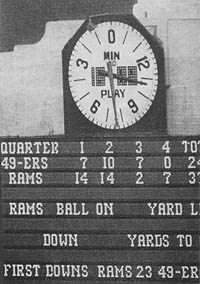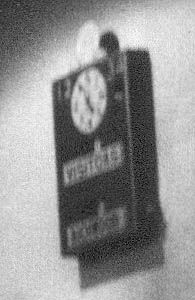Keeping Score
Written July 17, 2004
![]()
Some
little boys play with toy cars
and later
grow up to be auto mechanics.
Some
little girls play with dollhouses
and later
grow up to be homemakers.
This
little boy played with scoreboards
and later
grew up to be a graphics operator for sports telecasts.
It started with the arrival at our house of the November 1960 issue of Friends, a magazine for Chevrolet owners. This particular issue included a two-page spread about the giant scoreboard at the Los Angeles Coliseum.
|
|
|
How far away could 21-inch-high characters be seen? I ran a little experiment. I found that I could read one-inch-high characters easily from a distance of 17 feet, and I could still make them out from 25 feet. Scaling up by a factor of 21, this gave a range of about 350 to 525 feet for the Coliseum scoreboard. That meant that the numbers were indeed big enough to be read from the far end zone. I developed a general rule: the ratio of height to distance should be no less than 1 to 300 and preferably 1 to 200.
The article went on to explain how the board worked. Nowadays, of course, it would be computerized. But when it was built in 1938, that technology wasn't available.
|
|
So a miniature version was installed in a small room behind the big board. On this three-by-five-foot table were 11,500 sockets, each wired to one of the bulbs outside. From a filing case, the operators selected character blocks and inserted them into the panel. Each prong lit a bulb. |
|
To quickly change numbers (like the down and the yards to go), there were special gadgets, such as those being operated by the man on the far right. I deduced that each had up to 33 prongs that could be moved in and out of their circuits by the rotation of a wheel. And there were toggle switches for each row of type that could turn off the entire row, such as the promo OCT. 5 UCLA VS OREGON, until it was needed. |
|
|
|
All other scoreboards formed their characters out of simple rectangular arrays of light bulbs. The Coliseum board was classier, because its letters had serifs. To achieve this efficiently, the first and last of the seven rows were simply shifted horizontally by half a bulb. |
|
For some reason, I found all of this fascinating. Perhaps from childhood we're each predisposed to take an interest in what will become our life's work.
(At right: the Coliseum scoreboard during the first Super Bowl.) |
|
At the
time, I was a manager for our eighth-grade basketball team. But
the Claibourne-Richwood junior high school was housed in the old 1917
school building on Ea st
Ottawa Street, a building that had no gym. We had to hold our
basketball practices at the town hall three blocks away.
st
Ottawa Street, a building that had no gym. We had to hold our
basketball practices at the town hall three blocks away.
The gym at this "Opera House" was on the second floor, with a locker room half a floor above (outlined here in green). It had been the home floor for the basketball teams of Richwood High School for several seasons beginning in 1935, until the high school I attended was built. To reach it, one had to climb a flight of iron steps on the outside of the building. I recall that one of my duties was clearing the snow from these steps.
Criss Somerlot recalled, “John Merriman organized our fifth- and sixth- grade basketball teams. We each paid 25 cents a week for coal to heat the Opera House for practice (now that’s a deal).”
The Opera House facilities were Spartan and old-fashioned, as one might imagine. But it did have a real Fair-Play scoreboard like the one shown below.
|
|
I examined it closely, noting how the white bulbs were set into a metal egg crate that was covered with a sheet of dark red plastic. Again, each number was seven bulbs high. I sketched other possibilities and decided that the practical minimum was probably five bulbs. |
The coach, Don Parsons, saw me making my measurements and offered to power up the scoreboard so I could play with it, but I declined; I was on duty, and "play" was not in my job description as a team manager.
The next year, I was a Richwood High School freshman. This building (which became North Union Junior High School after I graduated) actually did have a gymnasium/auditorium. At freshman games, I sometimes was assigned to operate the scoreboard, which had probably been hanging on the wall since the high school was built in 1939. Here are two fuzzy photos.
|
The only parts that lit up were the numerals 12 34 to indicate the quarter. (Visitors sometimes would ask why the board seemed to be showing a score of twelve to thirty-four.) The analog clock had a second hand plus a larger hand that went around once in eight minutes, since that was the length of a high-school basketball period. However, the JV team, then called "reserves," played six-minute quarters. We had to allow them a two-minute break between periods so that we could run the clock forward. As the scoreboard operator, I had a small wooden box with switches for the quarter lights, clock, and horn. There was a bundle of wires coming out of it, of course, and there were also four pushbuttons for the score. The score numerals were painted on four black disks, arranged so that one digit at a time showed through the window above the team name. Each pushbutton activated an electric motor. The attached disk slowly turned 36° until it reached the next digit. There it paused for a couple of seconds, then rotated to the next digit, and so on, as long as I kept my finger on the button. But if I happened to give a point to the wrong team, it took almost a minute to correct the mistake by rotating the disk all the way back around. |
|
Even when I did my job properly, there were complaints. After a basket was scored, some fans might object that I had given their team only one point. Just wait a few seconds, I wanted to say; another point will be here soon.
Also, the scoreboard was located out of the view of some of the fans, who sat on bleachers erected on the stage nearby.
Despite the drawbacks, I adapted this technology in a speculative design for a larger scoreboard that could be used for football games.
But within a couple of years, the Richwood Boosters purchased a modern scoreboard with numbers that actually lit up, including a digital clock! You can see it on the left of this 1965 photo of an intramural game, with the old scoreboard still high on the wall at the right.

|
Meanwhile, I had discovered on television that there was an alternative to round light bulbs. The rocket scientists at Cape Canaveral needed only seven rectangular segments to form each digit on their countdown clocks. So I got out my Girder & Panel Construction Set, which included a green Masonite board with holes into which pegs could be placed. As shown in this drawing, I could insert red plastic "girders" between the pegs to form numbers. To keep myself occupied while listening to a basketball game on the radio, I'd rearrange the girders to keep track of the score. |
|
For football games, I sometimes posted the numbers on a small blackboard, including down and yards and so forth, using colored chalk. I must have entertained myself this way on December 15, 1962, when the Cleveland Browns ended their season at Kezar Stadium in San Francisco. A month later, we moved to a new house, and the blackboard ended up in the basement. I remember that the final remained on the board for a long time afterwards: Browns 13, 49ers 10.
 In
addition to the blackboard, I borrowed a clock: the electric
alarm clock from my parents' bedroom, seen here in another fuzzy
photo. It had a sweep second hand, and if I unplugged the
electricity, it stopped. I rigged up a switch so I could start
and stop the clock in response to the televised referee's signals.
In
addition to the blackboard, I borrowed a clock: the electric
alarm clock from my parents' bedroom, seen here in another fuzzy
photo. It had a sweep second hand, and if I unplugged the
electricity, it stopped. I rigged up a switch so I could start
and stop the clock in response to the televised referee's signals.
Keeping time and score was more fun than merely watching the game. In a way, I was now involved. And this playing around eventually led to my career in graphics for sports television.
In 1982, I had already working in local cable TV for a dozen years. My current job was with a company, TCS, which had other interests as well: they had recently built a remote broadcast truck and were starting to televise some Pittsburgh Pirates games on regional cable. They needed some cheap entry-level workers, and my boss, Tom Huet, asked whether I wanted to learn to be an audio engineer for these broadcasts. I replied, "Actually, that character generator looks more interesting to me." Okay, he said, we'll show you how to run it.
Before I knew it, I was keeping time and score for real!
















